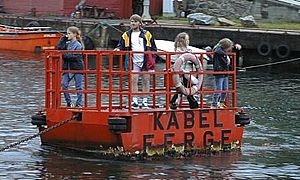Cable ferry facts for kids
A cable ferry is a special type of ferry that moves across a river or other body of water by following strong cables. These cables are stretched from one shore to the other. You might also hear them called chain ferries, swing ferries, floating bridges, or even punts.
Imagine a boat that pulls itself along a rope or wire, rather than using its own engine to push through the water. That's how a cable ferry works! Early versions of these ferries used thick ropes or heavy steel chains to guide them. This is why they were often called "chain ferries." But by the 19th century, stronger and more reliable wire cables became common, replacing the older ropes and chains.
Contents
How Cable Ferries Work
Cable ferries are quite clever in how they operate. They use the cables in different ways:
- Guidance: Sometimes, the cables just act like tracks, keeping the ferry on the right path. The ferry might have its own engine or even be pulled by another boat.
- Propulsion: Often, the ferry itself pulls on the cables to move across the water. It might have a special engine that winds the cable, or in simpler cases, people might even crank it by hand!
- Current Power: Some cable ferries use the natural flow of the water (the current) to push them across. They are angled in a way that the current pushes them along the cable, like a sailboat using the wind. These are sometimes called "reaction ferries."
These ferries are very useful in places where building a bridge would be too expensive or difficult. They are also great for shorter crossings.
Types of Cable Ferries
There are a few main ways cable ferries are set up:
- Overhead Cable Ferries: These ferries have a cable that stretches high above the water, from one shore to the other. The ferry hangs from this cable or is guided by it.
- Underwater Cable Ferries: In this type, the cables lie on the bottom of the river or lake. The ferry has special wheels or mechanisms that grip and pull along these submerged cables.
- Side-Attached Cable Ferries: Some ferries have cables attached to their sides, which are then pulled by machinery on the shore or on the ferry itself.
History of Cable Ferries
Cable ferries have been around for a very long time. People have used simple versions for centuries to cross rivers.
- Early Days: The first ferries likely used basic ropes and human or animal power to pull them across.
- Industrial Revolution: With the invention of steam engines and stronger materials like steel, cable ferries became more advanced. Engines could pull heavier loads, and wire cables were much more durable.
- Modern Use: Today, cable ferries are still used all over the world, especially in rural areas or on smaller waterways. They are an important part of the Public transport system in many communities.
Gallery
Images for kids
-
Cable ferry in Vaxholm, Sweden
-
This is the winding mechanism on the Sackville Ferry in New South Wales, Australia.
-
A simple cable ferry in Gee's Bend, Alabama from 1939.
-
White's Ferry on the Potomac River.
See also
 In Spanish: Transbordador de cable para niños
In Spanish: Transbordador de cable para niños































